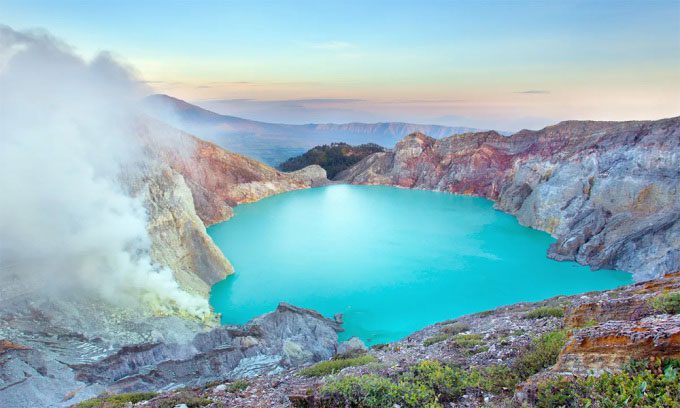The Ijen volcano complex is one of the famous destinations in Indonesia, featuring a large lake and particularly stunning blue flames that burn brightly.
The Ijen volcano complex in East Java, Indonesia, spans over 22 kilometers. This vast area with a complex geological structure boasts impressive landscapes during the day, but at night, the mountains emit a stream of “blue lava”.

Blue lava on Ijen volcano at night. (Photo: Mazur Travel)
Kawah Ijen is considered the only place on Earth where these blue flames exist continuously. However, the beauty of the Kawah Ijen volcano comes at a cost, as the high sulfur levels make the surrounding air toxic to anyone who inhales it.
The phenomenon of blue lava occurs due to the large amounts of sulfur “pockets” in the rock. Sulfur escapes when the rock melts and releases toxic gases like sulfur dioxide when burned. Sulfur ignites upon contact with oxygen, producing blue flames. While the volcanic lava appears entirely blue, in reality, only the surface of the lava is covered by the blue flames. The blue fire continuously burns on the surface of the lava but is hard to see during the day.
This vast volcanic complex is actually situated in a caldera – a depression formed when a volcano erupts and collapses, often creating a large lake at its center. The Ijen complex contains about 22 eruption points, primarily around the edges of the caldera.
The lake within the Ijen caldera has a stunning bright turquoise color, but it is also the largest acid lake in the world with a pH close to 0. Swimming in this lake can be life-threatening or at least cause severe injuries.

Acid lake in the center of Ijen caldera. (Photo: Mazur Travel)
With abundant sulfur, referred to by locals as “the devil’s gold,” this volcanic complex is one of the few places with manual sulfur mining activities. In Java, Indonesia, sulfur is used to produce matches and to whiten sugar. Visitors to the area must wear gas masks, but many miners cannot afford masks and only use cloth to cover their mouths. Without proper protective equipment, many workers face severe health issues, with one-third frequently suffering from respiratory diseases.
Ijen may be the only place with continuously burning blue flames, but this phenomenon can occur in areas containing certain gases in large concentrations. Some reports indicate that blue flames have appeared during wildfires in Yellowstone National Park, USA. There, sulfur around the hydrothermal vents ignited.
In 2018, the United States Geological Survey (USGS) released images showing blue flames seemingly erupting from the ground during the Kilauea volcano eruption in Hawaii. These flames formed due to the release of methane gas. This gas is released when lava from the eruption covers vegetation and prevents oxygen from reaching it. This incomplete combustion process releases methane gas, resulting in the blue flames.
The Dallol volcano in the Danakil Depression, Ethiopia, also emits blue lava, but this is a rare occurrence. Each time it appears, the blue flames will burn for a few days. They also form from hydrothermal vents and sulfur springs within the depression.


















































